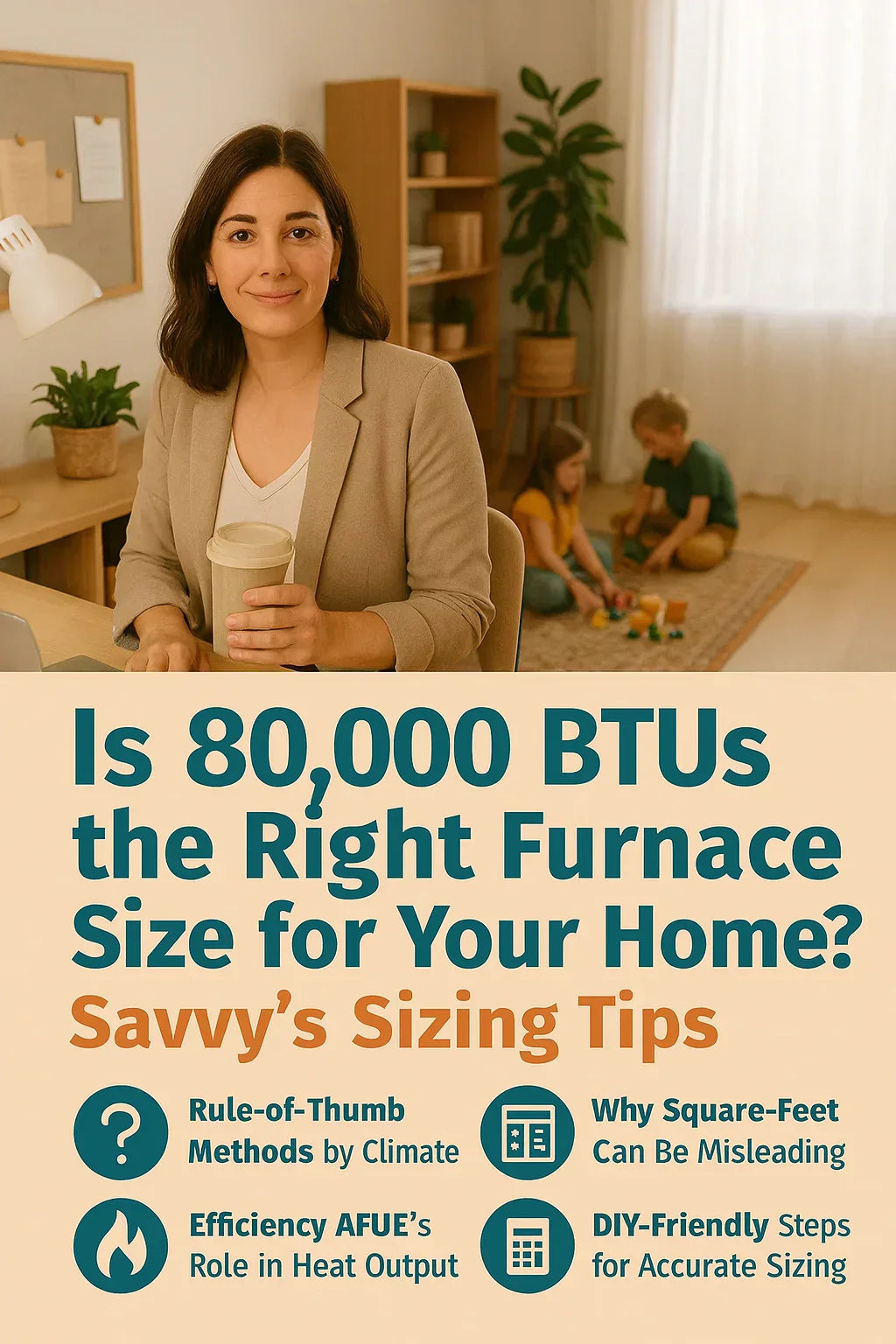1. Why Furnace Size Really Matters
Choosing the right furnace size isn’t just about heating power—it’s about comfort, efficiency, and your wallet. Too small, and your house stays cold on the chilliest nights; too big, and your unit cycles frequently, wasting energy and money.
As The Spruce points out, “choosing the right size furnace is crucial to avoid wasted energy and expensive maintenance”
So, is that 80,000 BTU furnace going to be just right? Let’s dig in.
2. Understanding BTUs & How They Work
BTUs—or British Thermal Units—measure the energy needed to raise one pound of water by one degree Fahrenheit. In HVAC terms, they measure a furnace’s heat output per hour.
Wikipedia defines AFUE (Annual Fuel Utilization Efficiency) as the average, season-long efficiency of a furnace—i.e., if a furnace has 90% AFUE, it delivers 90 BTUs of heat for every 100 BTUs of fuel burned
So while BTUs tell you how much heat your furnace can make, AFUE tells you how much of that work actually keeps your home warm.
3. Rule-of-Thumb Sizing by Square Footage and Climate
For DIYers, a quick, ballpark way to estimate furnace size is to multiply your home’s square footage by a BTU range adjusted for climate:
-
Warm climates: ~30–35 BTU/sq ft
-
Moderate climates: ~40–45 BTU/sq ft
-
Cold climates: ~50–60 BTU/sq ft
Modernize gives an example: for a 2,000 sq ft home, you’d need about 60,000–80,000 BTU
PickHVAC also notes that homes around 1,500 sq ft typically use 60,000–80,000 BTU depending on climate
4. How Much Home Can an 80,000 BTU Furnace Heat?
According to hvacoptimizer.net, an 80,000 BTU furnace can condition roughly 2,000 to 2,500 sq ft, depending on variables like insulation and climate
Combine that with general rules, and here’s a rough guide:
| Climate Zone | Home Size Supported by 80,000 BTU |
|---|---|
| Warm | ~2,500 sq ft |
| Moderate | ~2,000–2,200 sq ft |
| Cold | ~1,800 sq ft |
Bottom line? For most average-sized homes, 80,000 BTU is in the ballpark—but “Savvy” homeowners know to dig deeper before buying.
5. Factors Beyond the Numbers: Insulation, Layout, Windows & Ceiling Height
Insulation & Envelope Quality
A poorly insulated home might need 20% more BTUs, while a well-insulated one might need less
Floor Plan & Room Sizes
Large, open rooms with vaulted ceilings need more heating. Lots of glazing (windows), doors, or poor insulation all raise needed output.
Sunlight & Orientation
Homes with lots of sun exposure may need 10% less capacity; shaded homes might need 10% more
Occupants & Internal Heat
Yes, people generate heat! Passive gains from occupants, appliances, and lighting can slightly reduce required capacity.
6. Efficiency Matters: AFUE and Its Role in Sizing
Remember: Your furnace's input rating isn’t the same as its output rating—efficiency covers the gap.
AC Direct illustrates: if a 90,000 BTU input furnace has 80% efficiency, that equals about 72,000 BTU output
If you're planning on an 80,000 BTU furnace, make sure it’s efficient—otherwise, your effective heat delivered could be much lower.
7. The Gold Standard: Manual J Heat-Load Calculations
For precise sizing, HVAC professionals use ACCA Manual J, considering everything from square footage and insulation levels to window types, local climate data, occupancy, and more.
As Energy Vanguard emphasizes, simple “square feet” rules of thumb can vary wildly—especially when you factor in things like window orientation and infiltration
If you’re serious about hitting the sweet spot in comfort and efficiency, get a Manual J done. For a DIY-starter, websites like The Furnace Outlet help explain what goes into heating needs and urge proper professional input
8. Savvy’s Sizing Strategy: A Step-by-Step Example
Let’s walk through a Savvy-style sizing process for an 80,000 BTU furnace:
Step 1: Measure Your Space
Let’s say your house is 2,100 sq ft in a moderate climate.
Step 2: Use Rule-of-Thumb Range
Using 45 BTU/sq ft:
2,100 × 45 = 94,500 BTU
That’s a lot more than 80k—but that’s because rule-of-thumb errs on the safe side.
Step 3: Adjust for Insulation & Layout
If your home is well-insulated and gets good midday sun, reduce estimate by 10%:
94,500 × 0.9 ≈ 85,000 BTU
Step 4: Calculate Output Based on AFUE
If your furnace is 95% AFUE, output = furnace input × 0.95. To get about 80,000 BTU, you'd need ~84,200 BTU input.
Step 5: Test It
That lines up nicely with an 80,000 BTU high-efficiency unit—if your home conditions match assumptions.
Step 6: When to Call a Pro
If variance is over ±20%, or if your home has unique features (multiple stories, vaulted ceilings, old construction), get a Manual J to verify.
9. What Happens If Your Furnace Is Oversized or Undersized?
Undersized Furnace
-
Runs continuously in cold conditions
-
Struggles to maintain temperature
-
Higher energy costs and more wear
Oversized Furnace
-
Short-cycling: turns on/off quickly
-
Uneven heating and humidity issues
-
More energy wasted and higher stress on components
The Spruce sums it up: a furnace that falls outside the correct size range wastes energy and breaks down faster
Wrapping It Up: Savvy Final Tips
-
80,000 BTU can be a great choice for many moderate-sized, well-insulated homes—but don’t assume it's a one-size-fits-all.
-
Always consider climate, insulation, layout, ceilings, and efficiency (AFUE) before locking in.
-
Use rule-of-thumb formulas for quick estimates—but when in doubt, let a technician perform a Manual J for accuracy.
-
Remember: Effective furnace sizing equals comfort, efficiency, and peace of mind—and that’s what Savvy homeowners love most.
In the next topic we will know more about: Two-Stage Furnaces Explained: Why Variable Speed Matters for Comfort & Savings







